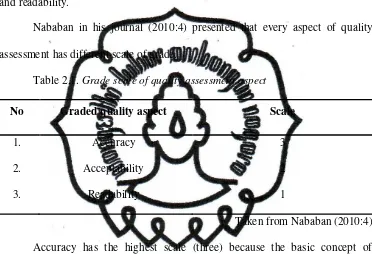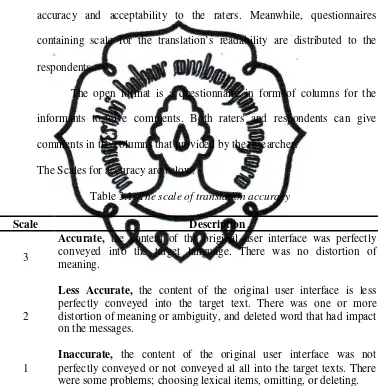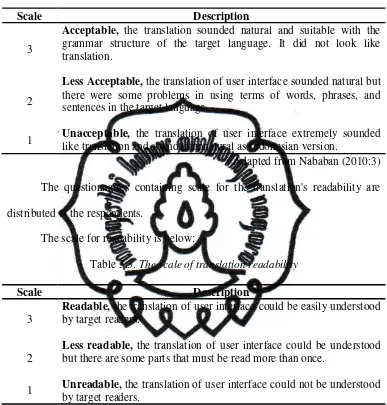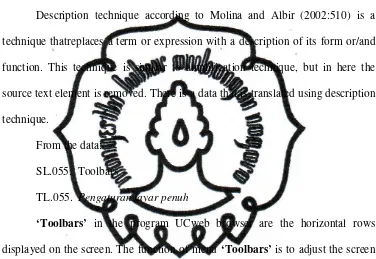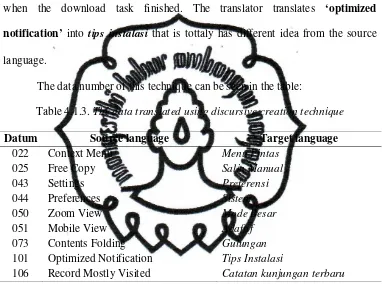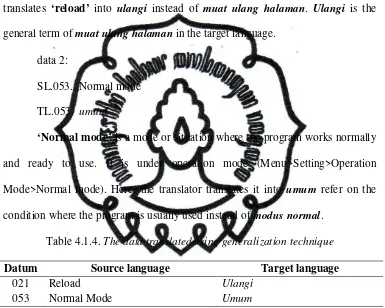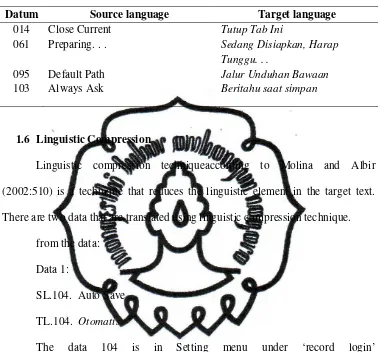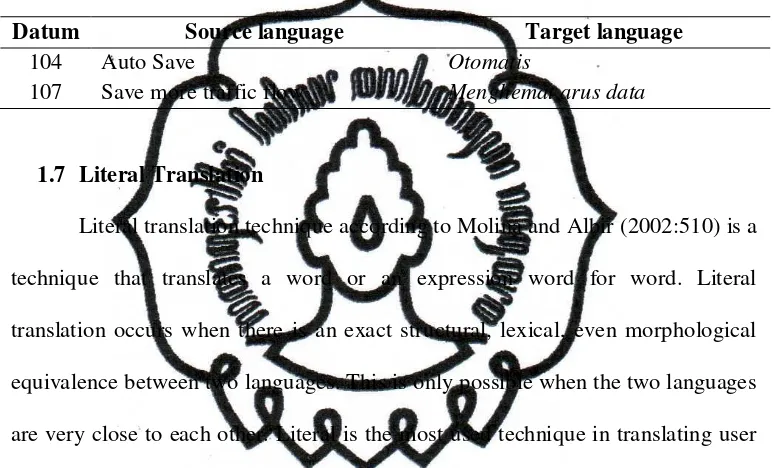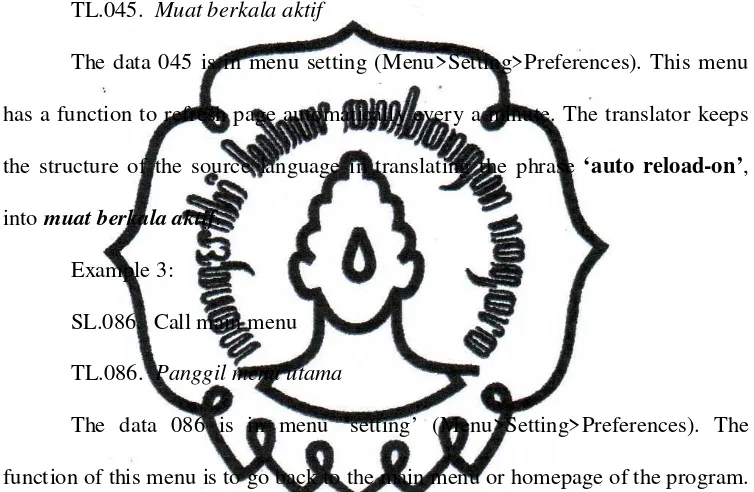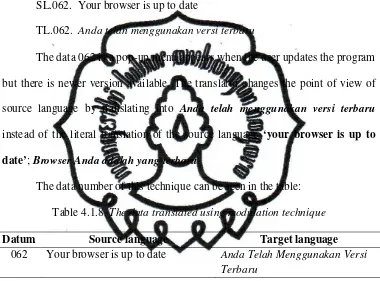commit to user
Analysis of Translation Technique and Quality
Assessment as Part of Software Localization:
UCweb Browser
THESIS
Submitted as a Partial Fulfillment of the Requirements for The Sarjana Sastra Degree in English Department
By:
BUNTAR TRI ANGONO C0307013
ENGLISH DEPARTMENT
FACULTY OF LETTERS AND FINE ARTS SEBELAS MARET UNIVERSITY
commit to user
iiTHESIS APPROVAL
Analysis of Translation Technique and Quality
Assessment as Part of Software Localization:
UCweb Browser
By:
BUNTAR TRI ANGGONO C0307013
Approved to be Examined before the Board of Examiners Faculty of Letters and Fine Arts
Sebelas Maret University
Thesis Supervisor:
Prof. Drs. M.R. Nababan, M.Ed., M.A.,Ph.D. NIP. 1963.0328.199201.1001
Head of English Department
commit to user
iiiAnalysis of Translation Technique and Quality
Assessment as Part of Software Localization:
UCweb Browser
By:
BUNTAR TRI ANGGONO C0307013
Accepted and approved by the Board Examiners Faculty of Letters and Fine Arts Sebelas Maret University
August 2012 The Board Examiners
Position Name Signature
Chairman : Drs. Agus Hari Wibowo, M.A., Ph.D. ... NIP. 19670830 199302 1001
Secretary : Ardianna Nuraeni, S.S, M.Hum ... NIP. 19820927 200612 2001
First Examiner : Prof. Drs. M.R Nababan, M.Ed.,M.A., Ph.D. ... NIP. 19630328 199201 1001
Second Examiner : Ida Kusuma Dewi, S.S, M.A. ... NIP. 19710525 199802 2001
The Dean of Faculty of Letters and Fine Arts Sebelas Maret University
commit to user
ivPRONOUNCEMENT
Name: Buntar Tri Anggono NIM : C0307013
Stated whole-heartedly that the thesis entitled “Analysis of Translation Technique and Quality Assessment as Part of Software Localization: UCweb Browser” is originally made by the researcher. It is not plagiarism, nor made by the others. The things related to other people’s work are written in quotation and included within the bibliography.
If it is then proved that the researcher cheats, the researcher is ready to take the responsibility.
Surakarta, July 2012 The researcher
commit to user
vMOTTO
commit to user
viDEDICATION
This thesis is dedicated to you,
commit to user
viiACKNOWLEDGEMENT
Alhamdulillahirobbil’alamin. I thank to The God, Allah SWT for everything given to me, so I can finish this thesis as a partial fulfillment of graduating requirement of Sarjana Degree.
In finishing this thesis, I realize that without supports from the people surrounding me, I am sure that I cannot finish it successfully. I would like to give my deepest gratitude to all the people who have given valuable contributions. My special thanks to:
1. All my families. Thank you for all supports given to me. I could not be here without you all.
2. My thesis supervisor, Prof. Drs. M.R. Nababan, M.Ed., M.A., Ph.D., , for his assistance.
3. The Dean of the Faculty of Letters and Fine Arts, Drs. Riyadi Santosa, M.Ed., Ph.D., for approving this thesis.
4. The Head of English Department of Sebelas Maret University, Drs. Agus Hari Wibowo, M.A., Ph.D., for giving me admission to this thesis to be examined.
5. My academic consultant, Fitria Akhmerti, P, S.S, M.A., for guidance during my study.
commit to user
viii7. My raters, Mr. Dion, Miss. Vian, and Miss. Arum, for comments, input, and suggestion.
8. Himawan, Rizky, and Nita, for being my respondents.
9. All my friends in English Department, especially ED’07, thanks for togetherness. Graduation is not the finish line, it is the starting one.
10. GoogleTM and any other websites that provide me online-helping. It is hard to imagine work without them in this era.
11. UCweb Mobile Ltd. Thank you for the precious product that I can use as my object of research.
12. My ‘more than a friend’, Nitha, thanks for all support given to me.
13. Last but not least, thanks to all parties those have contributed in writing this thesis.
I do realize that this thesis is far away from being perfect. Any supporting criticism and suggestion will be kindly accepted. I hope this thesis will be beneficial for the people especially student of English Department who are interested in translation study.
Surakarta, July 2012
commit to user
ixTABLE OF CONTENTS
Approval by Thesis Supervisor ... ii
Approval by Board of Examiners ... iii
Pronouncement ... iv
Motto ... v
Dedication ... vi
Acknowledgement ... vii
Table of Contents ... ix
List of Tables ... xii
Abstract ... xiv
CHAPTER I: INTRODUCTION A. Research Background ... 1
B. Research Limitation ... 4
C. Problem Statement ... 4
D. Research Objectives ... 4
E. Research Benefit ... 4
F. Thesis Organization ... 5
CHAPTER II: LITERATURE REVIEW A. Definition of Translation ... 7
commit to user
xC. Translation Quality Assessment ... 18
D. Software Localization ... 24
E. UCweb Browser... 28
CHAPTER III: RESEARCH METODOLOGY A. Type of Research ... 31
B. Data and Source or Data... 32
C. Sample and Sampling technique ... 33
D. Method of Data Collection ... 34
E. Technique Data Analysis ... 36
F. Research Procedure ... 37
CHAPTER IV: ANALYSIS AND DISCUSSION A. Introduction ... 39
B. Analysis ... 39
1. Translation Techniques ... 39
2. Translation Quality... 63
2.1 Accuracy ... 64
2.2 Acceptability ... 77
2.3 Readability ... 83
commit to user
xiCHAPTER V: CONCLUSION AND RECOMMENDATION
A. Conclusion ... 116
B. Recommendation ... 117
BIBLIOGRAPHY ... 118
commit to user
xiiLIST OF TABLES
Table 2.1 : Grade scale of quality assessment aspect ... 22
Table 3.1 : The scale of translation accuracy ... 34
Table 3.2 : The scale of translation acceptability ... 35
Table 3.3 : The scale of translation readability... 35
Table 4.1.1 : Borrowing ... 40
Table 4.1.2 : Description ... 40
Table 4.1.3 : Discursive creation ... 42
Table 4.1.4 : Generalization ... 43
Table 4.1.5 : Linguistic amplification ... 45
Table 4.1.6 : Linguistic compression ... 46
Table 4.1.7 : Literal translation ... 47
Table 4.1.8 : Modulation ... 50
Table 4.1.9 : Naturalization ... 52
Table 4.1.10 : Particularization ... 52
Table 4.1.11 : Reduction ... 53
Table 4.1.12 : Transposition ... 54
Table 4.1.13 : Couplet ... 56
Table 4.1.14 : Triplet ... 61
Table 4.1.15 : Translation techniques ... 62
Table 4.2.1 : Accurate translations ... 69
commit to user
xiiiTable 4.2.3 : Inaccurate translation ... 77
Table 4.2.4 : Acceptable translation ... 81
Table 4.2.5 : Less acceptable translation ... 87
Table 4.2.6 : Unacceptable translation ... 89
Table 4.2.7 : Readable translation ... 93
Table 4.2.8 : Less readable translation ... 100
Table 4.3.1 : Borrowing & Translation Quality ... 101
Table 4.3.2 : Description & Translation Quality ... 101
Table 4.3.3 : Discursive creation & Translation Quality ... 102
Table 4.3.4 : Generalization & Translation Quality ... 103
Table 4.3.5 : Linguistic amplification & Translation Quality .. 104
Table 4.3.6 : Linguistic compression & Translation Quality ... 105
Table 4.3.7 : Literal translation & Translation Quality... 105
Table 4.3.8 : Modulation & Translation Quality ... 107
Table 4.3.9 : Naturalization & Translation Quality ... 107
Table 4.3.10 : Particularization & Translation Quality... 108
Table 4.3.11 : Reduction & Translation Quality ... 109
Table 4.3.12 : Transposition & Translation Quality ... 110
Table 4.3.13 : Couplet & Translation Quality ... 110
commit to user
xivABSTRACT
Buntar Tri Anggono. C0307013. Analysis of Translation Technique and Quality Assessment as Part of Software Localization: UCweb Browser. Thesis: English Department, Faculty of Letters and Fine Arts. Sebelas Maret University. 2012.
This research belongs to descriptive qualitative method. A purposive sampling technique was employed in this research. There are 132 data consisting of clauses, phrases, and sentences taken from the user interface of program UCweb browser and their translation. The other data were taken from the questionnaires assessed by three raters and three respondents.
The analysis shows that there are 14 techniques used by the translator in translating the user interface of program UCweb browser. They were borrowing, description, discursive creation, generalization, linguistic amplification, linguistic compression, literal translation, modulation, naturalization, particularization, reduction, transposition, couplet, and triplet.
The analysis on the translation accuracy indicates that 95 data (71.97%) from overall data are categorized accurate, 25 data (18.94%) are less accurate, and 12 data (9.09%) are inaccurate. The analysis on the translation acceptability shows that 99 data (75%) from overall data are categorized acceptable, 32 data (24.24%) are less accurate, and a datum (0.76%) is unacceptable. The analysis on the translation readability indicates that 118 data (89.4%) are categorized readable, 14 data (10.6%) are less readable, and there is no data considered unreadable
1. Student of English Department, Student Number C.0307013
2012.The study focuses on the translation of the user interface of a program UCweb mobile web browser. The purposes of this study are to find out the techniques used by the translator and to describe the effect of the techniques on the translation quality of the words of the user interface in the software UCweb browser
This research belongs to descriptive qualitative method. A purposive sampling technique was employed in this research. There are 132 data consisting of clauses, phrases, and sentences taken from the user interface of program UCweb browser and their translation. The other data were taken from the questionnaires assessed by three raters and three respondents.
The analysis shows that there are 14 techniques used by the translator in translating the user interface of program UCweb browser. They were borrowing, description, discursive creation, generalization, linguistic amplification, linguistic compression, literal translation, modulation, naturalization, particularization, reduction, transposition, couplet, and triplet.
The analysis on the translation accuracy indicates that 95 data (71.97%) from overall data are categorized accurate, 25 data (18.94%) are less accurate, and 12 data (9.09%) are inaccurate. The analysis on the translation acceptability shows that 99 data (75%)
on the translation readability indicates that 118 data (89.4%) are categorized readable, 14 data (10.6%) are less readable, and there is no data considered unreadable
1. Mahasiswa Jurusan Sastra Inggris dengan NIM C.0307013 2. Dosen Pembimbing I
3. Dosen Pembimbing II
Buntar Tri Angoono.1
Prof. Drs. M.R Nababan, M.Ed.,M.A., Ph.D.2
Ida Kusuma Dewi, S.S, M.A.3
ABSTRAK
2012. Penelitian ini mengfokuskan pada terjemahan dari antar muka pengguna dari sebuah program peramban jaringan perangkat bergerak UCweb. Tujuan dari penelitian ini adalah untuk menemukan teknik yang digunakan oleh penerjemah dan untuk menjelaskan efek dari teknik terhadap kualitas terjemahan pada kata-kata yang terdapat pada antar muka di dalam perangkat lunak peramban UCweb.
Penelitian ini menggunakan metode qualitatif deskriptif. Teknik penarikan contoh digunakan dalam penelitian ini. Ada 132 data terdiri dari klausa, phrasa, dan kalimat yang diambil dari antar muka pengguna dari program peramban UCweb dan terjemahannya. Data lainnya diperoleh dari kuisioner yang dinilai oleh tiga penaksir dan tiga responden.
Analisis menunjukkan ada 14 teknik yang digunakan oleh penerjemah dalam menerjemahkan antar muka dari program peramban UCweb. Terdiri dari teknik peminjaman (borrowing), deskripsi (description), kreasi diskursif (discursive creation), generalisasi (generalization), amplifikasi linguistik (linguistic amplification) kompresi linguistik (linguistic compression), penerjemahan harfiah (literal translation), modulasi (modulation),
teknik (couplet), dan penerjemahan tiga teknik (triplet).
Analisis pada keakurasian terjemahan menunjukkan bahwa 95 data (71,07%) dari seluruh data dikategorikan akurat, 25 data (18,94%) kurang akurat, dan 12 data (9.09%) tidak akurat. Analisis pada keberterimaan terjemahan menunjukkan bahwa 99 data (75%) dari keseluruhan data dikategorikan berterima, 32 data (24,24%) kurang berterima, dan 1 data (0,76%) tidak berterima. Analisis pada tingkat keterbacaan terjemahan menunjukkan bahwa 118 data ( 89,4%) dari keseluruhan data memiliki tingkat keterbacaan tinggi, 14 data (10,6%) memiliki tingkat keterbacaan sedang, dan tidak ada data yang memiliki tingkat keterbacaan rendah.
commit to user
CHAPTER I
INTRODUCTION
A. Research Background
The usage of mobile web browser increases year by year globally because it is easy in use, and high mobility. The condition also happens in Indonesia. Indonesia has a great number of Internet mobile users. Considering the fact, some developers provide their product with the Indonesian version. The purposes are to get more costumers in Indonesia and to make the costumer easier in using their product.
Software localization is the best way for a product to reach global market. Web Collins in her journal (2002:1) argues that in 2001, less than 15 percent of US Corporation offered non-English content. In the same time, approximately 65 percent of users were non-English speakers. Moreover, previous studies showed the costumers were as much as three times more likely to purchase products that use their native language.
commit to user
2
A translator should perfectly master the target languages and have a very good knowledge in the technical field. A translator also should be skilled with the specific vocabulary. It is essential for the translator to be familiar with the software in order to fully understand the context of the phrases. For the best result, the translator should collaborate with the development team continuously.
This research was conducted to find out the translation techniques and the quality assessment of the user interface in the program: UCweb mobile web browser. UCweb is one of web browser developers that provide their product with Indonesian version. Certainly, most of Indonesian people prefer to use the English version of software rather than Indonesian one. It is caused of the Indonesian version has some user interface and instruction that are unable to understand by the users. Some Internet and computer terms in the program are translated literally. Below are some examples of the terms in the program user interface.
Example 1
English Indonesian
Access Point Titik Akses
The Encarta dictionary notes that ‘access point’ isa transceiver in a wireless local area network that connects a wired local area network to wireless devices. The target text is accurate and acceptable. Somehow it lacks the readability because it is not specific enough. People who do not familiar about Internet and computer terms will not understand the real meaning of titik akses
commit to user
3
English Indonesian
My shortcut Kunjungan Cepat
The sites of www.merriam-webster.com notes that shortcut is a file contain address (as of a document or Web site) on the computer or Internet. ‘My shortcut’ is translated into kunjungan cepat. Both source language and target language have similar meaning in a way that they both refer to the same thing. However, they have the different degree of meaning since my shortcut is more specific than kunjungan cepat.
Example 3:
English Indonesian
Cache Size Pengaturan Cache
Cache is a computer memory for storing or hiding data with a very short access time (www.merriam-webster.com). In here, the word “cache” is not translated into target text since the translator uses borrowing technique. The word “size” is not accurately translated as “pengaturan”. However, both source language and target language refer to the same thing: how to manage the cache.
commit to user
4
B. Research Limitation
This study is limited to the words and terms of the user interface in the software UCweb mobile web browser English and Indonesian version. The focus of analysis includes the types of translation techniques used by the translator, and the effect of the techniques to the translation quality.
C. Problem Statement
Considering the research background, the problems are formulated as follows:
1. What techniques are the translators used to translate words of the user interface in the software UCweb browser?
2. What are the effects of the techniques on the translation quality of the words of the user interface in the software UCweb browser?
D. Research Objectives
The objectives of this study are as follows:
1. To find out the techniques used by the translator to translate words of the user interface in the software UCweb browser.
commit to user
5
E. Research Benefit
It is expected that the study will be beneficial to: 1. Translators
Translating is not only transferring the message from the source text into the target text, but also considering the cultural background of the target readers. A translator must be having at least bilingual ability, mastering translation theory, and noticing the cultural background of the target readers. From this research, it is supposed that translators will get a response or additional information, it hopes they will aware and be more careful in localizing software.
2. Lectures
Most of Indonesian people still prefer to use English as user interface language in software or program. It is for whom access to English. For them who do not know about English, they will get difficulties in using a program. From this research, it is expected that lectures can get additional information about Internet and computer terms that can be used as a material source to teach their students, especially those who interest in translation study.
3. Students and other researchers
commit to user
6
F. Thesis Organization
This thesis is arranged into five chapters;
CHAPTER I:
In the chapter I, the researcher introduces the Background of The Research, Research Limitation, Problem Statement, Research Objectives, Research Benefits, and Thesis Organization.
CHAPTER II:
Chapter II is about literature review that discusses the theory and studied related to the research. This chapter consists of Definition of Translation, Translation Techniques, Translation Quality Assessment, Software Localization, and UCweb Browser Profile.
CHAPTER III:
Chapter III is the method used by the researcher in conducting the research. This chapter discusses the Type of The Research, Data and Source of Data, Sampling Technique, Method of Data Collection, and Method of Data Analysis.
CHAPTER IV:
Chapter IV is the main part of this thesis. It is divided into two parts which are analysis and the discussion. It covers Translation Techniques, Translation Quality, and Discussion.
CHAPTER V:
commit to user
CHAPTER II
LITERATURE REVIEW
A. Translation Definition
Some experts have provided definitions concerning translation. Roger T. Bell (1991: 5) states that translation was the expression in another language of what has been expressed in another source language, preserving semantics and stylistic equivalence. Bell's concept was concerning equivalence in both semantics and stylistic aspects corresponds very well with the idea given by Nida and Taber (1974:4) "translating consists of reproducing the receptor language the closest natural equivalence to the message of the source language first in meaning and secondly in style". Both expert definitions underline the equivalence of translation not only as meaning but also style.
The more comprehensive definition concerning translation was provided by Brislin (1976:1)
"Translation is the general term referring to the transfer of thoughts and ideas from one language (source) to another (target), whether the languages are in written or oral form: whether the languages have established orthographies or do not have standardization whether one or both languages are based on signs, as of language of the deaf."
commit to user
9The two following definitions agree with the whole definitions above in the way of underlining the notion of equivalence. They are given by Newmark (1981:7) and Catford (1965:20). Newmark uttered that translation was a craft consisting effort to replace a written message and/or statement in one language by the same message and/or statement in another language, and Catford stated that translation was the replacement of textual material equivalently in one language to another language.
Considering the statements above, it can be concluded that translation is a process of transferring message from source language to the target language, which should consider the content of the messages, the language structures, and the style as well. To a large extent, the different linguistic and cultural systems between source and target languages can cause the problem of equivalence.
Overall the process of translating a source text, a translator is exceptionally required to understand the content of the text then to produce the equivalence in the target text, as natural and close as possible.
B. Translation Techniques
commit to user
10language, including the choice of equivalents. There are several techniques used in translation. The following definitions are based on a journal of Molina and Albir (2002:509-511):
1. Adaptation
Adaptation according to Molina and Albir (2002:509) is a technique that replace a source text element with one from the target culture. In some case, a cultural or social element from the source text is replaced with a different one, but corresponding element in the translation. It is usually something that is more familiar to the intended audience.
Example:
ST: Alvin and friends play baseball in the school yard.
TT: Alvin dan teman-teman bermain sepak bola di halaman sekolah.
‘Baseball’ is not a common sport in Indonesian and the term cannot be found in the target language, so the translator replaces with sepak bola that is well known for the target readers.
2. Amplification
Amplification technique according to Molina and Albir (2002:510) is a technique that introduces details that are not formulated in the source text. It can be written directly or type in the footnote. This technique gives an explanation about the source language term, so it can be understood by the target reader .
commit to user
11 ST: Mary gives me a pizza.TT: Mary memberiku sepotong pizza (roti bundar yang terdapat irisan daging dan sayuran diatasnya).
For the readers who are not familiar with any foreign word or term in this case is the word ‘pizza’, the translator gives a brief explanation about it as roti bundar yang terdapat irisan daging dan sayuran diatasnya.
3. Borrowing
Borrowing technique according to Molina and Albir (2002:510) is a translation technique that takes word or expression straight from another language. The translator makes a conscious choice to use the same word in the target text as it is found in the source text. This is particularly the case when there is no equivalent term in the target language. It also allows the translator to put a text clearly within a particular cultural context through the register of used vocabulary.
Example:
ST: Pair cellphone and computer through Bluetooth.
TT: Hubungkan telepon genggam dan computer dengan Bluetooth.
commit to user
124. Naturalization
Naturalization technique according to Molina and Albir (2002:510) is similar to the borrowing technique, but with any changes to fit the spelling rules in target language. According to Newmark (1988), naturalization technique transferred and adapted the source language word to the normal pronunciation, then to the normal morphology (word-forms) of the target language.
Example:
ST: John is a taxy driver.
TT: John adalah seorang sopir taksi.
The word ‘taxy’ is borrowed and modified into taksi where consonant –x-
is changed into –ks- and consonant –y is changed into vowel -i to fit on Indonesian spelling rules.
5. Calque
Calque technique according to Molina and Albir (2002:510) is a literal translation of foreign word or phrase. It can be lexical or structural. Calques are special kind of borrowing where a language borrows a word or an expression from another language and translates literally each of its elements.
Example:
commit to user
13The term ‘black box’ in the source text means onboard data-recording device used in various forms of transport is borrowed and translated literally into target text becomes kotak hitam.
6. Description
Description technique according to Molina and Albir (2002:510) is a technique that replaces a term or expression with a description of its form or/and function. This technique is similar to amplification technique, but in here the source text element is removed.
Example:
ST: I will make you a cup of cappuccino.
TT: Aku akan membuatkanmu secangkir kopi dengan susu yang ditaburi bubuk coklat.
The translator deletes the word ‘cappuccino’, and replaces it with the description of cappuccino itself in the target text.
7. Generalization
Generalization technique according to Molina and Albir (2002:510) is a technique that uses more general or neutral term. It happens when there is no equivalence word in the target text, so the translator generates it into super ordinate or general term.
Example:
commit to user
14 TT: Salju di pagi hari.‘Flake’ is a small piece of snow. It is translated into salju because there is no subordinate of the word salju in the target language.
8. Modulation
Modulation technique according to Molina and Albir (2002:510) is a technique that changes the point of view, focus or cognitive category in the source text; it can be lexical or structural. Although the main characteristic of modulation is a change of point of view, it may also involve a change of grammatical categories. It is used when the other techniques would generate a text that is grammatically correct, but unsuitable, not idiomatic, or awkward.
Example:
ST: Barack Obama will rule the US country.
TT: Barack Obama akan menjadi presiden Amerika serikat.
The words ‘will rule’ is translated into akan menjadi presiden that changes the point of views that also involves the change in the grammatical category.
9. Particularization
commit to user
15transferred into target text, it replaced with a more specific term to make acceptable to the target reader.
Example:
ST: I enjoy rain in the morning.
TT: Aku menikmati gerimis di pagi hari ini.
‘Rain’ in here is translated into sub-ordinate of hujan: gerimis to make it acceptable. Sparingly most of the people do not enjoy the rain, but in any case, few people enjoy a situation of the little rain with their partner.
10. Reduction
Reduction technique according to Molina and Albir (2002:510) is a technique that suppresses the information item in the target language. It opposes to amplification. It happens when the addition element of the source text is familiar to the target reader.
Example:
ST: I will back to Indonesia in Ramadan (the month of fasting) TT: Aku akan pulang ke Indonesia saat Ramadhan.
The information added in the source text is deleted because the target readers have been familiar with the term Ramadhan.
11. Compensation
commit to user
16another place in the target text because it cannot be reflected in the same place as in the source text. It allows the translator to transfer a stylistic difficulty into another section of the text.
Example:
ST: Kill two birds with one stone.
TT: Sekali mendayung, dua tiga pulau terlampaui.
The element in the source text cannot be reflected into the target text, so it is replaced with element in the target text having similar meaning.
12. Discursive Creation
Discursive creation technique according to Molina and Albir (2002:510) is a technique that technique establishes a temporary equivalence that totally unpredictable out of context. This technique is usually used in translating book, or film title.
Example:
ST: Tears of the sun (Antoine Fuqua) TT: Perang sipil Afrika barat
commit to user
1713. Established Equivalent
Established equivalent technique according to Molina and Albir (2002:510) is a technique that uses a term or expression recognized by dictionaries or language in use as an equivalent in the target language.
Example: ST: Black rose
TT: Mawar Hitam
The word ‘black rose’ is translated into mawar hitam and that is listed in the dictionary.
14. Linguistic Amplification
Linguistic amplification technique according to Molina and Albir (2002:510) is a technique that adds the linguistic elements in the target text. This is often used in consecutive interpreting and dubbing.
Example: ST: Let me see.
TT: Biar aku saja yang membukakan pintunya.
commit to user
1815. Linguistic Compression
Linguistic compression technique according to Molina and Albir (2002:510) is a technique that reduces the linguistic elements in the target text. It is often used in simultaneous interpreting and in subtitling.
Example:
ST: You can eat all the meal. TT: makanlah.
The target text is reduced linguistically by deleting subject ‘You’ and objects ‘all the meal’, and then translated into makanlah.
16. Literal translation
Literal translation technique according to Molina and Albir (2002:510) is a technique that translates a word or an expression word for word. Literal translation occurs when there is an exact structural, lexical, even morphological equivalence between two languages. This is only possible when the two languages are very close to each other.
Example:
ST: He reads a book.
TT: Dia membaca sebuah buku.
commit to user
1917. Substitution
Substitution technique according to Molina and Albir (2002:511) is a technique that changes the linguistic elements into paralinguistic element (intonation, gestures) or vice versa. It is used above all interpreting.
Example:
ST: I cross my finger for your successful English test.
TT: Aku mendoakanmu semoga berhasil dalam ujian Bahasa Inggris. The paralinguistic element in the source text ‘cross my finger’
transferred into linguistic element to the target text mendoakan.
18. Variation
Variation technique according to Molina and Albir (2002:511) is a technique that changes linguistic or paralinguistic elements (intonation, gestures) that affect aspect of linguistic variation: changes of textual tone, style, social dialect, geographical dialect, etc.
Example:
ST: He cuts the head of enemy with his sword. TT: Dia membunuh musuhnya dengan pedang.
The element of the source text ‘cut the head’ is changed into membunuh
to make it acceptable for the target reader when adapting text for the children.
commit to user
20Transposition technique according to Molina and Albir (2002:511) is a technique that changes a grammatical category; the semantics elements are transferred to grammatically different groups of words. This technique is used in order to overcome the problem related to different language systems.
Example:
ST: My sister brings the book. TT: Buku itu dibawa adikku.
The element category in the source text is changed grammatically. ‘my sister’ as subject in the source text become object in the target text and so does
‘book’ as object in the source text becomes subject in the target text. Verb is also changed into V3/ passive in the target text.
20.Couplet
Couplet according to Newmark (1988:91) occurs when the translator uses two techniques to translate a single unit of translation.
Example:
ST. High capacity memory TT. Memorikapasitas tinggi
commit to user
2121.Triplet
Triplet according to Newmark (1988:91) is a combination of three techniques that are used in translating a single unit of translation.
Example:
ST: An expensive green computer mouse
TT. Sebuah mouse komputer berwarna hijau daun yang mahal
The data is translated using three techniques. The word ‘mouse’ is borrowed from the source text. The word ‘green’ is expanded into berwarna hijau daun, and the word ‘computer’ and ‘expensive’ are translated literally into
komputer and mahal. The combination of three techniques is called triplet.
C. Translation Quality Assessment
Translation quality assessment is an evaluation of the translation product. The purpose for doing the assessment is to make sure that the target text contains the same idea, thought, and message as the source language. Al-Qinai (2000:499) states that the assessment of a translated text sought to measure the degree of efficiency of the text with regard to the syntactic, semantics, and pragmatic function of source text within the cultural frame and expressive potentials of both source language and target language.
commit to user
22level in common. Larson (1984: 485) underlines that “There were three main reasons for translation assessment. The translator wants to be sure his translation is accurate, clear and natural”. From the statements, it can be concluded that translation quality assessment involves three components; accuracy, acceptability, and readability.
Nababan in his journal (2010:4) presented that every aspect of quality assessment has different scale of grade.
Table 2.1. Grade scale of quality assessment aspect
No Graded quality aspect Scale
1. Accuracy 3
2. Acceptability 2
3. Readability 1
commit to user
231. Accuracy in Translation
Accuracy is a measurement of correctness. Accuracy in assessment of translated text is correctness in transferring message from the source text to the target text. Shuttleworth and Cowie in their Dictionary of Translation (1997:44) put into words:
"Accuracy is a term used in translation evaluation to refer to the extent to which a translation matches its original. While it is usually refers to preservation of the information content of source text in target text, with an accurate translation being generally literal rather than free, its actual meaning in the context of a given translation must depend of the type of equivalence."
Shuttleworth and Cowie explained that accuracy deals with the content or the message of the text. Referring to the definition, it can be said that there are two things considered in accuracy. The first thing is the degree, and the second one is correctness.
2. Acceptability in Translation
Accept means agree to take. Acceptability in translation quality assessment is the ability of the transferred information to be recognized by the readers based on knowledge and environment surroundings in their language. It relates to the naturalness of translation text to the target reader. Acceptability deals with the linguistic and the cultural bounds of the target reader.
commit to user
24culture and the awareness of the reader. Acceptability is closely related to culture and mindset of target reader.
Another statement about acceptability is defined by Toury (1980:80)
“Translations which lean towards acceptability can thus be thought of as fulfilling the requirement of ‘reading as an original’ rather than ‘reading as the original’ and consequently generally have a more natural ‘feel’”.
Toury was using the term “acceptability” to criticize the traditional theory of translation, which is oriented to the source text. He suggested the target-text-oriented approach, and recommends the translation belongs primarily to the target literary system.
3. Readability in Translation
The word “read” means understand. Readability in translation quality assessment is the ability of a target text to be understood grammatically as the original by the target reader. According to Richard et al. in Nababan (2008:62) readability was ‘how easily written materials can be read and understood’. In here, the readers are the readability determinant of a translated text.
Dale and Chall (1949 in Dubai 2004:3) provide the detail being lacking in general definition about readability:
“The total (including all the interactions) of all those elements within a given piece of printed material that affects the success a group of readers have with it. The success is the extent to which they understand it, read it at an optimal speed, and find it interesting.”
commit to user
25many factors. Nababan (1997:102) states that readability depends on new and/or difficult vocabulary, the length of the sentence, the grammatical and language complexities used in the text, and text organization. In short, readability is closely related to how easy a target text can be understood by the reader about the grammar and the structure.
Richard et al. in Nababan (2003:63) states that there are factors influencing readability level in translation. They were average sentence long, the total of new words, and complex grammatically used language. Nababan (2003:64-78) adds several factors in readability; new words, vernacular, foreign language, equivocal words, incomplete sentence, average length of sentence, Incoherent train of thought, and complex sentence.
a. New words
Sometimes new words make the reader difficult to understand the messages. New words are words that are strange or uncommon for them. It will decrease the readability level of a text. For example the words sangkil and
mangkus that are introduced by linguist only known in several groups of people.
b. Vernacular
commit to user
26 c. Foreign languageSometimes, foreign language found in a text, especially in short story or novel. For example, novel entitled Ayat-Ayat Cinta tells about an Indonesian student who studies in Al-Azhar, Egypt. In the story, there are several dialogues using Egyptian. It will make the reader cannot understand the text well.
d. Equivocal words
Equivocal word has more than one meaning. Susilowati (2010:43) provides an example of equivocal; “The truck driver stopped at the pub and drained the dragon”. The sentence has two meanings, the truck driver stopped at the pub and drained the radiator, or the truck driver stopped at the pub and go to the toilet. In Australia, drained the dragon is a euphemism of go to the toilet.
e. Incomplete sentence
A complete sentence commonly consists of subject, predicate, object and adverbial. If one of the components is missing, the sentence will become incomplete. Incomplete sentence can lead the readers in reading the text. For example is Panji, murid paling nakal di kelas. The sentence is not complete because there is no predicate in it, and it makes the sentence ambiguous. f. average length of sentence
commit to user
27sentences are more difficult to comprehend than long sentences. It depends on the reader’s ability in reading the text.
g. Incoherent train of thought
In some cases, there are texts that written in good grammar, but have no coherent in the train of thought. It will make the text difficult to understand. h. complex sentence
Complex sentences have more than one idea written in a sentence. It also determines the readability level of a text.
D.Software Localization
Software localization is the process of redesigning the software to fit the requirements, so it can be received by the target market. Software localization according to Web Collins: (2002:74) is the translation and adaptation of software, including the software itself and all related product documentation, making the software more usable to target customers.
Software localization is more than just the translation of the user interface of the product. Translation process usually spends a lot of work hours and huge effort from the development teams. Some localizations process outsourced to specialized companies to reduce costs.
commit to user
28Sometimes, there are several mistakes occur in process of translating software. The translator ignores localization and their specific elements like date and number format, address structure, etc., and the translator fails to use simple and familiar text to the most people.
E. UCweb Browser
UCweb (http://en.ucweb.com) is a new mini web browser for mobile device. It is supporting for almost handset types both low memory phones and high-end phones, and almost software platform; S60, Java, Android, iOS, Bada, Windows CE, MTK, and BREW. UCweb browser is developed by UC mobile Ltd that located in Guangzhou, China. With their slogan, “help you to put the Internet in your pocket!” UCweb provide the easier and faster way to connect to the Internet using cellular phones. User can go online directly to many social networks and any other websites. The other benefit of using UCweb, user can feel the computer-like browsing experience, because the program is featured with cursor, copying data ability, and download manager.
Pic 1.(UCweb browser Indonesian version) Pic 2. (UCweb browser English version)
Tabloid Pulsa online edition (http://tabloidpulsa.co.id/news/48-news/664- uc
commit to user
29commit to user
CHAPTER III
RESEARCH METHODOLOGY
A. Type of Research
The research uses quantitative and qualitative techniques that are mixed in a single study. Quantitative research according to Charoenruk (2007:1) is a research concerning with investigation which can be observed and measured in some way and Qualitative research according to Marshal and Rossman in Charoenruk (2007:1) is a research which attempts to increase our understanding of why things are the way they are in our social world and why people act the way they do. The research combines specific characteristic of both quantitative and qualitative researches to make a description about a phenomenon. The quantitative data is data in numerical form, derived from questionnaires that are stuffed by the informants. The researcher uses type of qualitative research by describing the result of data analysis, not in the numerical form but in the form of words.
commit to user
31
The research is an embedded case study because the researcher only investigates the specific aspect of a particular case: (1) The translation techniques that are used in translating user interface of UCweb browser (2) The quality of translation of the UCweb user interface.
B. Data and Source of Data
The data of this research are all phrases, clauses, and sentences of user interface in UCweb in English and their translation in Indonesian. The other data are numerical form derived from questionnaires that the researcher has spread to the informants. This research involves two groups of informants. The first group comprises raters. Three raters are involved in the research. The raters assess the quality of the translation for accuracy and acceptability. The second group consists of three respondents. The respondents assess the quality of the translation for readability.
The source data used in this study are UCweb browser English and Indonesian version. Both are developed by UC mobile Ltd, Guangzhou, China. The other data sources are the questionnaires that are distributed to the raters and respondents. The decision to take the UCweb browser as the source of data because on the following considerations:
commit to user
32
2. There are different ways in expressing clauses, phrases, and sentences in the English version and its Indonesian translation which influences the meaning. Therefore, the translator should apply the right and proper technique in translating clauses, phrases, and sentences in order to get the right meaning in Indonesia.
C. Sample and Sampling Technique
The researcher uses purposive sampling in determining the data. First data sources are phrases, clauses and sentences written as user interface in UCweb that were translated into Indonesian. Second data are data in form of numerical based on the questionnaire. The informants are divided into two groups, first group comprises raters and the second group comprises correspondents, both groups accomplish some specific criteria.
The informants used in this research are those who meet the criteria. The first group comprises three raters. The criteria for raters are:
1. mastered English and Indonesian languages
2. had competency and experience as a translator
3. had adequate knowledge about translation
4. would to take part in the research
The second group comprises some correspondents. The criteria for respondents were:
commit to user
33 2. Would to take part in the research
3. User of UCweb Browser
The three respondents were students of UNS with different major program. College students were possible target users because most of college students were Internet user.
D. Method of Data Collection
In collecting the data, the researcher applies to non-interactive method consisting of content analysis and questionnaire distribution.
D.1. Content Analysis
In conducting content analysis, the researcher follows the following steps:
a. Downloading and using UCweb browser English and Indonesian browser.
b. Comparing clauses, phrases, and sentences of user interface in both English version and its translation.
c. Taking the data from the source data to identify the translation techniques used by the translator.
d. Analyzing the techniques used by the translator to render clauses, phrases, and sentences into Indonesian.
commit to user
34
There are two kinds of questionnaire: (1) Closed format and (2) Open format. The closed format is in the form of scaled questionnaire, used to assess the translation's accuracy, acceptability and readability. The researcher distributes questionnaires containing scale for the translation's accuracy and acceptability to the raters. Meanwhile, questionnaires containing scale for the translation’s readability are distributed to the respondents.
The open format is a questionnaire in form of columns for the informants to give comments. Both raters and respondents can give comments in the columns that provided by the researcher.
The Scales for accuracy are below:
Table 3.1. The scale of translation accuracy
Scale Description
3
Accurate, the content of the original user interface was perfectly conveyed into the target language. There was no distortion of meaning.
2
Less Accurate, the content of the original user interface is less perfectly conveyed into the target text. There was one or more distortion of meaning or ambiguity, and deleted word that had impact on the messages.
1
Inaccurate, the content of the original user interface was not perfectly conveyed or not conveyed al all into the target texts. There were some problems; choosing lexical items, omitting, or deleting.
commit to user
35
Table 3.2. The scale of translation acceptability
Scale Description
3
Acceptable, the translation sounded natural and suitable with the grammar structure of the target language. It did not look like translation.
2
Less Acceptable, the translation of user interface sounded natural but there were some problems in using terms of words, phrases, and sentences in the target language.
1 Unacceptable, the translation of user interface extremely sounded like translation and sounded unnatural as Indonesian version.
Adapted from Nababan (2010:3) The questionnaires containing scale for the translation's readability are distributed to the respondents.
The scale for readability is below:
Table 3.3. The scale of translation readability
Scale Description
3
Readable, the translation of user interface could be easily understood by target readers.
2
Less readable, the translation of user interface could be understood but there are some parts that must be read more than once.
1 Unreadable, the translation of user interface could not be understood by target readers.
Adapted from Nababan (2010:4)
E. Technique Data Analysis
commit to user
36
Secondly, the researcher makes classifications of the translation accuracy, acceptability, and readability that are applied by the raters and the respondents after the questionnaires have been distributed. The researcher counts the percentage of each classification by calculating the total number of it.
Finally, the researcher draws some conclusions and gives some recommendations from the result of analysis.
F. Research Procedure
Research procedures are carried by the researcher to obtain the final are as follows:
1. Downloading and rewriting the user interface of UCweb browser English and Indonesian version.
2. Collecting clauses, phrases, and sentences from English version software and its translation.
3. Classifying the data according the kind of the texts and its impossible meaning in the target language.
4. Coding the data in order to make the data classification and the data analysis easy to understand.
commit to user
37
5. Analyzing and classifying data, based on the translation techniques occurred in the translation of user interface into Indonesian.
6. Distributing the questionnaires to the raters and respondents for checking the translation accuracy, acceptability, and readability.
7. Collecting score given by raters and respondents.
8. Identifying and classifying the data, based on the characteristics.
9. Making statistical calculation of the classified data.
10. Analyzing the determination relating them to theoretical context of the study.
commit to user
CHAPTER IV
ANALYSIS AND DISCUSSION
A.INTRODUCTION
This chapter discusses the results of data analysis to answer the problem statements of the research. This research uses content analysis. The researcher reviews all the data of UCweb user interface and examine the translation technique used, then classify the data into several categories.
B. ANALYSIS
The first part presents the techniques used by the translator in translating the user interface of UCweb software. Then, the second analysis would be about the quality of the translation. It presents the analysis of the accuracy, acceptability, and readability of the translation. It would provide the findings of the research based on the questionnaires which were completed by the raters and respondents.
1. Translation Techniques
commit to user
39(1988:91)used by the translator to translate user interface from the source language into the target language. They are borrowing, description, discursive creation, generalization, linguistic amplification, linguistic compression, literal translation, modulation, naturalization, particularization, reduction, transposition techniques, couplet and triplet.
1.1 Borrowing
Borrowing technique according to Molina and Albir (2002:510) is a technique thattake the word or expression directly from another language. This is particularly the case when there is no equivalent term in the target language. It also allows the translator to put a text clearly within a particular cultural context through the register of used vocabulary. There is a data that is translated using borrowing technique.
from the data: SL.009. Tab TL.009. Tab
The data 009 is under main menu. It can be found at Menu>Tab. Tab menu used to add or close a tab, and to switch between tab in the program. The translator borrows word ‘tab’ from the source language because there is no equivalent word in the target language.
commit to user
40Table 4.1.1. The data translated using borrowing technique
Datum Source language Target language
009 Tab Tab
1.2 Description
Description technique according to Molina and Albir (2002:510) is a technique thatreplaces a term or expression with a description of its form or/and function. This technique is similar to amplification technique, but in here the source text element is removed. There is a data that is translated using description technique.
From the data: SL.055. Toolbars
TL.055. Pengaturan layar penuh
‘Toolbars’ in the program UCweb browser are the horizontal rows displayed on the screen. The function of menu ‘Toolbars’ is to adjust the screen whether it will be full screen or not. It can be found under setting menu (Menu>Setting>Toolbars). The translator deletes the source language and describes the function of the menu ‘Toolbars’ topengaturan layar penuh.
The data number of this technique can be seen in the table: Table 4.1.2. The data translated using description technique
Datum Source language Target language
commit to user
411.3 Discursive Creation
Discursive creationaccording to Molina and Albir (2002:510) is a technique that establishes a temporary equivalence that totally unpredictable out of context. There is a data that is translated using discursive creation technique.
Some example from the data: Example 1:
SL.050. Zoom view TL.050. Mode besar
The function of the menu‘zoom view’, is to control the magnification of the screen. It is found under Browse mode (Menu>Setting>Browse mode>Zoom view).The translator prefers to translate the data into mode besar using discursive creation technique to appropriate with menu ‘browse mode’ormode jelajahin the target language.
Example 2:
SL.073. Content folding TL.073. Gulungan
The function of the menu‘Content folding’is to control the folding of the contents. The user only need to click the symbol ‘-‘ to fold up the contents, it will give a clean and simple clean. If the user clicks the symbol ‘+’, the contents will be displayed. The data 073 is in menu ‘setting’ (Menu>Setting>Preferences).
‘Content folding’ is translated into gulunganthat has different meaning from the source language.
commit to user
42 SL.101. Optimized NotificationTL.101. Tips Instalasi
The Data 101 is in menu ‘setting’ (Menu>Setting>Preferences) under ‘download’ menu. The option ‘optimized notification’ is to give notification when the download task finished. The translator translates ‘optimized notification’ into tips instalasi that is tottaly has different idea from the source language.
The data number of this technique can be seen in the table:
Table 4.1.3. The data translated using discursive creation technique
Datum Source language Target language
022 Context Menu Menu Pintas
025 Free Copy Salin Manual
043 Settings Preferensi
044 Preferences Sistem
050 Zoom View Mode Besar
051 Mobile View Adaftif
073 Contents Folding Gulungan
101 Optimized Notification Tips Instalasi
106 Record Mostly Visited Catatan kunjungan terbaru
1.4Generalization
Generalization technique according to Molina and Albir (2002:510) is a technique that applies a more general or neutral term in the target language. It makes the translator generate it into superordinate term. There are two data that are translated using generalization technique.
commit to user
43 SL.021. ReloadTL.021. Ulangi
The data 021 is under navigation menu (Menu>Navigation>Reload).
‘Reload’ in here has a function to refresh the page of a website. The translator translates ‘reload’ into ulangi instead of muat ulang halaman. Ulangi is the general term of muat ulang halaman in the target language.
data 2:
SL.053. Normal mode TL.053. umum
‘Normal mode’ is a mode or situation where the program works normally and ready to use. It is under operation mode (Menu>Setting>Operation Mode>Normal mode). Here, the translator translates it into umum refer on the condition where the program is usually used instead of modus normal.
Table 4.1.4. The data translated using generalization technique
Datum Source language Target language
021 Reload Ulangi
053 Normal Mode Umum
1.5Linguistic amplification
Linguistic amplification technique according to Molina and Albir (2002:510) is a technique that adds linguistic elements in the target text.There are four data that are translated using linguistic amplification technique.
commit to user
44 SL.014. Close currentTL.014. Tutup tabini
The data 014 is under tab menu (Menu>Tab>Close current). The translator adds linguistic element objecttab in the target language tutup tab ini because of the command menu ‘close current’ belongs to command menu ‘tab’. It can help the user to adapt with the program easily especially when he/she want to close the tabs.
Example 2:
SL.061. Preparing . . .
TL.061. Sedang disiapkan. Harap tunggu. . .
The data 061 is pop-up information under update menu (Menu>Setting>Update). The function of the pop-up is to inform the user that update the program is in progress. The translator adds linguistic element notice
harap tunggu. It means the user needs to be patient while the task is loading. Example 3:
SL.095. Default path
TL.095. Jalur unduhan bawaan
The data 095 is in menu ‘setting’. (Menu>Setting>Preferences). The menu
‘default path’ controls where to save the download file. The translator adds element subjectunduhan in the target language to make clear the function of the menu.
commit to user
45Table 4.1.5. The data translated using linguistic amplification technique
Datum Source language Target language
014 Close Current Tutup Tab Ini
061 Preparing. . . Sedang Disiapkan, Harap Tunggu. . .
095 Default Path Jalur Unduhan Bawaan
103 Always Ask Beritahu saat simpan
1.6 Linguistic Compression
Linguistic compression techniqueaccording to Molina and Albir (2002:510) is a technique that reduces the linguistic element in the target text. There are two data that are translated using linguistic compression technique.
from the data: Data 1:
SL.104. Auto Save TL.104. Otomatis
The data 104 is in Setting menu under ‘record login’ (Menu>Setting>Preferences). The function of the option is to save the record login automatically. In the target language, the translator deletes linguistic element verb ‘save’ and translates ‘auto save’ into otomatis.
Example 2:
SL.107. Save more traffic flow TL.107. Menghemat arus data
commit to user
46user the benefit of the program in compressing the data.The translator does not translate element adjective ‘more’ and just translate ‘save more traffic flow’ into
menghemat arus data.
The data number of this technique can be seen in the table:
Table 4.1.6. The data translated using linguistic compression technique
Datum Source language Target language
104 Auto Save Otomatis
107 Save more traffic flow Menghemat arus data
1.7 Literal Translation
Literal translation technique according to Molina and Albir (2002:510) is a technique that translates a word or an expression word for word. Literal translation occurs when there is an exact structural, lexical, even morphological equivalence between two languages. This is only possible when the two languages are very close to each other. Literal is the most used technique in translating user interface of UCweb software. There are 62 data that are translated using literal technique.
Some example from the data: Example 1:
SL.013. Open in background TL.013. Buka di latar
commit to user
47language in the texts above have similar structure. The phrase ‘open in background’ can be literary translated into buka di latar.
Example 2:
SL.045. Auto reload-on TL.045. Muat berkala aktif
The data 045 is in menu setting (Menu>Setting>Preferences). This menu has a function to refresh page automatically every a minute. The translator keeps the structure of the source language in translating the phrase ‘auto reload-on’, into muat berkala aktif.
Example 3:
SL.086. Call main menu TL.086. Panggil menu utama
The data 086 is in menu ‘setting’ (Menu>Setting>Preferences). The function of this menu is to go back to the main menu or homepage of the program. In translating this phrase, the translator use word-for-word translationbecause between source and target language are close to each other.
The data number of this technique can be seen in the table:
Table 4.1.7. The data translated using literal translation technique
Datum Source language Target language
001 Starting Mulai
002 Open Buka
003 Homepage Beranda
006 Search Cari
007 History Riwayat
